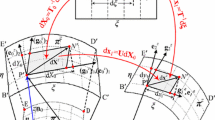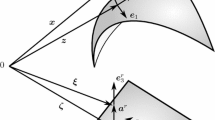Abstract
The viscoplastic deformation behavior of the shell is governed by any of the more recently proposed unified constitutive models with internal state variables and with the assumption that the total strain rate tensor can be decomposed additively into an elastic and an inelastic part. For the numerical analysis of viscoplastically deformed shells we use a hybrid strain finite element based on a geometrically linear theory of inelastic shells proposed by Kollmann and Mukherjee (1985). This theory gives the reduction of a two-field variational principle originally proposed by Oden and Reddy (1974) for elastic shells to the shell midsurface. It contains strain and displacement rates as variables to be independently varied. The shell formulation of this variational principle is the basis for the present work. First, a general hybrid finite element model is derived in which the shape functions for the strain and displacement rates can be polynomials of different order. Here we use the term “hybrid” in the sense of Pian (1988), i.e. in our two-field finite element the strain rates are condensed statically on the element level, leaving nodal displacements as the only unknowns in the final matrix equation. Then the finite element model is specialized for an axisymmetrically loaded conical shell with linear approximation of the strain rate field and quadratic interpolation of the displacement rates. Special emphasis is given to the derivation of the inelastic pseudo-forces and pseudo-moments. Numerical results for elastically and viscoplastically deformed shells are presented, where viscoplastic deformations are described by Hart's (1976) constitutive model.
Similar content being viewed by others
References
Anand, L. (1985): Constitutive equations for hot-working of metals. Int. J. Plast. 1, 213–232
Banthia, V.; Mukherjee, S. (1985): On an improved time integration for stiff constitutive models of inelastic deformation. Trans. ASME. J. Eng. Mater. Technol. 107, 282–285
Cordts, D.; Kollmann, F. G. (1986): An implicit time integration scheme for inelastic constitutive equations with internal state variables. Int. J. Numer. Methods Eng. 23, 533–554
Cormeau, I. (1987): Elastoplastic thick shell analysis by viscoplastic solid finite elements. Int. J. Numer. Methods 12, 203–227
Hart, E. W. (1976): Constitutive relations for the non-elastic deformation of metals. Trans. ASME. J. Eng. Mater. Technol. 98, 193–202
Hart, E. W. (1984): A micromechanical basis for constitutive equations with internal state variables. Trans. ASME. J. Eng. Mater. Technol. 106, 322–325
Hartmann, G.; Kollmann, F. G. (1987): A computational comparison of the inelastic constitutive models of Hart and Miller. Acta Mech. 69, 139–165
Hughes, T. J. R.; Liu, W. K. (1981a): Nonlinear finite element analysis of shells. Part 1: Three-dimensional shells. Comput. Methods Appl. Mech. Eng. 26, 333–362
Hughes, T. J. R.; Liu, W. K. (1981b): Nonlinear finite element analysis of shells. Part 2: Two-dimensional shells. Comput. Methods Appl. Mech. Eng. 27, 167–181
Hughes, T. J. R.; Tezduyar, T. E. (1981): Finite element based upon Mindlin plate theory with particular reference to the four-node bilinear isoparametric element. Trans. ASME, J. Appl. Mech. 48, 587–594
Kollmann, F. G.; Bergmann, V. (1986): A new finite element for geometrically linear, inelastic analysis of axisymmetric plates and shells. Ithaca: Cornell University, Dept. of Theor. Appl. Mech. (Unpubl. rpt.)
Kollmann, F. G.; Mukherjee, S. (1985): A general, geometrically linear theory of inelastic thin shells. Acta Mech. 57, 41–67
Kumar, V.; Mukherjee, S. (1977): A boundary-integral equation formulation for time-dependent inelastic deformation in metals. Int. J. Mech. Sci. 19, 713–724
Kumar, V.; Mukherjee, S.; Huang, F. H.; Li, C.-Y. (1979): Deformation in type 304 austenitic stainless steel. Final report EPRI NP-1276, Elastric Power Research Institute, Palo Alto, CA
Lee, S. W.; Pian, T. H. H. (1978): Improvement of plate and shell finite elements by mixed formulations. AIAAJ. 16, 29–34
Miller, K. A. (1976a): An inelastic constitutive model for monotonic cyclic and creep deformation. Part 1: Equations development and analytical procedures. Trans. ASME. J. Eng. Mater. Technol. 98, 97–105
Miller, K. A. (1976b): An inelastic constitutive model for monotonic, cyclic and creep deformation. Part 2: Applications to type 304 stainless steel. Trans. ASME. J. Eng. Mater. Technol. 98, 106–113
Mukherjee, S. (1982): Boundary element methods in creep and fracture. London, New York: Applied Science Publishers
Mukherjee, S.; Kollmann, F. G. (1985): A new rate principle suitable for analysis of inelastic deformation of plates and shells. Trans. ASME, J. Appl. Mech. 52, 533–535
Naghdi, P. M. (1972): Foundations of elastic shell theory. In: Sneddon, I. N.; Hill, R. (eds): Progress in solid mechanics, vol. 4, pp. 3–90. Amsterdam: North Holland
Oden, J. T.; Reddy, J. N. (1974): On dual complementary variational principles in mathematical physics. Int. J. Eng. Sci. 12, 1–29
Parisch, H. (1981): Large displacements of shells including material nonlinearities. Comput. Methods Appl. Mech. Eng. 27, 183–204
Pian, T. H. H. (1988): Overview of hybrid finite element methods for solid mechanics. In: Atluri, S. N., Yagawa, G. (eds): Computational mechanics'88, Proc. Int. Conf. Comput. Eng. Sci. April 10–14, Atlanta, GA, vol. 2, pp. 37. I. 1–37, I. 4. Berlin Heidelberg New York: Springer
Rand, R. (1984): Computer algebra in applied mathematics: An introduction to MACSYMA. Boston: Pitman
Robinson, D. H. (1975): A candidate creep recovery model for 2-1/4 Cr-1 Mo steel and its experimental implementation. Oak Ridge: Oak Ridge National Laboratory, report ORNL-TM-5110
Walker, K. P. (1981): Research and development program for nonlinear structural modeling with advanced time-dependent constitutive relationships. Lewisville: NASA, NASA-report no. CR-165530
Timoshenko, S. P.; Woinowsky-Krieger, P. (1970): Theory of plates and shells. 2nd edn. Tokyo: Mc Graw-Hill
Xue, W.-M.; Atluri, S. N. (1985): Existence and stability, and discrete BB and rank conditions, for general mixed-hybrid finite elements in elasticity. In: Spilker, R.; K. W. (eds): Hybrid and mixed finite element methods. New York: American Society of Mechanical Engineers, ASME publication AMD-Vol. 73
Zienkiewicz, O. C.; Bauer, J.; Morgan, K.; Onate, E. (1977): A simple and efficient element for axisymmetric shells. Int. J. Numer. Methods Eng. 11, 1545–1558
Author information
Authors and Affiliations
Additional information
Communicated by E. Stein, November 10, 1989
Rights and permissions
About this article
Cite this article
Kollmann, F.G., Bergmann, V. Numerical analysis of viscoplastic axisymmetric shells based on a hybrid strain finite element. Computational Mechanics 7, 89–105 (1990). https://doi.org/10.1007/BF00375924
Issue Date:
DOI: https://doi.org/10.1007/BF00375924




